Future of Work: 8 Megatrends Shaping Change
“The greatest danger in times of turbulence is not the turbulence itself, but to act with yesterday’s logic.”1
– Peter Drucker, Management Consultant, Educator, and Author
We live in uncertain times. While the acronym VUCA (for our ‘Volatile, Uncertain, Complex, and Ambiguous’ world) may have originated from military minds in the post-Cold War period, the eagerness and ease with which the business world has adopted it to describe today’s global economy is striking.2 It’s estimated that as many as half of the world’s CEOs now view uncertainty as the single biggest external threat to their business.3
The only way to find answers to the uncertainty we anticipate and the change that we fear is to ask the right questions. This was the impetus behind ‘The Future of Work Is Here’ report from GetSmarter. Based on findings from over 106 countries and 8,000 respondents, this research offers significant insight into the current and future impact of disruptive and convergent forces, helping business leaders and organizations globally uncover meaningful tools for navigating change.
Humans driving change
In the current zeitgeist, it can sometimes feel as if the march of progress is a speeding train, erratically driven by technology, in which we – the passengers – have no control over the outcome or destination. However, in truth, humans remain the real drivers of this change, and the digital acceleration we currently experience hasn’t removed the human element from the equation – it’s arguably made it more central.4 Essentially, humans are the change, and as the change is shifting, so are we.
Professor Klaus Schwab, founder and executive chairman of the World Economic Forum, has repeatedly stressed that we stand on the cusp of a Fourth Industrial Revolution that is to be distinctly “human-led and human-centered.”5
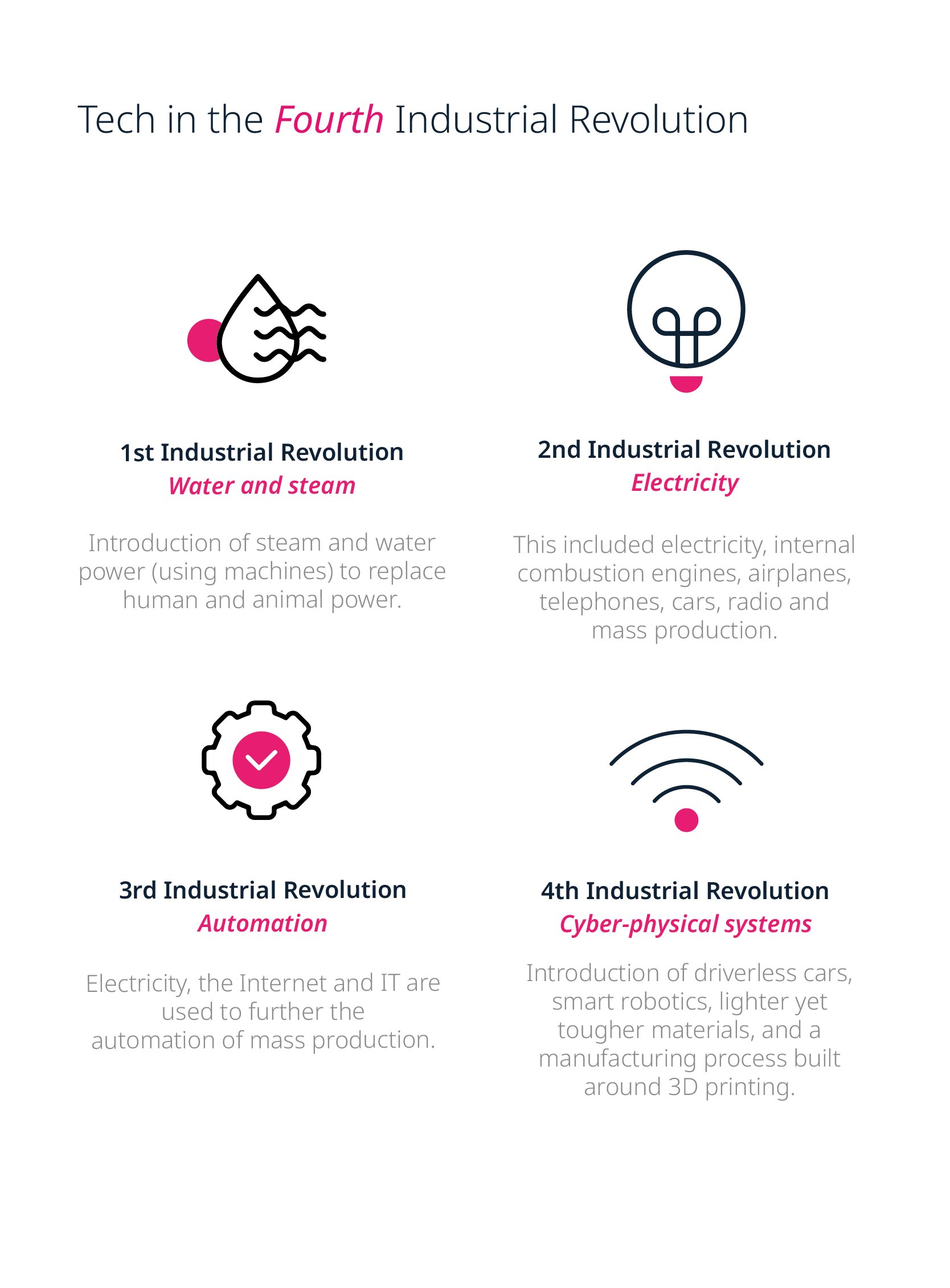
It was Schwab too who coined the term the “Fourth Industrial Revolution” (4IR) at the World Economic Forum’s annual meeting in Davos in 2016.6 Unlike previous industrial revolutions, he and others suggest that this one will see the lines blurred between the physical, digital, and biological spheres across all sectors, changing the way we live, work, and interact.7 And it’s happening now.
The 4IR is bigger, faster, and more all-encompassing than anything humanity has experienced before. The emergence of dynamic new technologies, coupled with megatrends like greater mobility and connectedness, globalization, resource scarcity, and fundamental changes to the makeup of the human population means change is to be found everywhere, occurring simultaneously to create a whole new order (thus, this is a ‘revolution’ and no mere ‘transformation’).8
Change is happening faster and more broadly than ever could have been anticipated. This is clearly reflected in GetSmarter’s research, where most respondents profess to have already experienced significant levels of change in their organization or jobs over the last 18 months. Furthermore, respondents are expecting even more significant change to occur in the next 18 months.
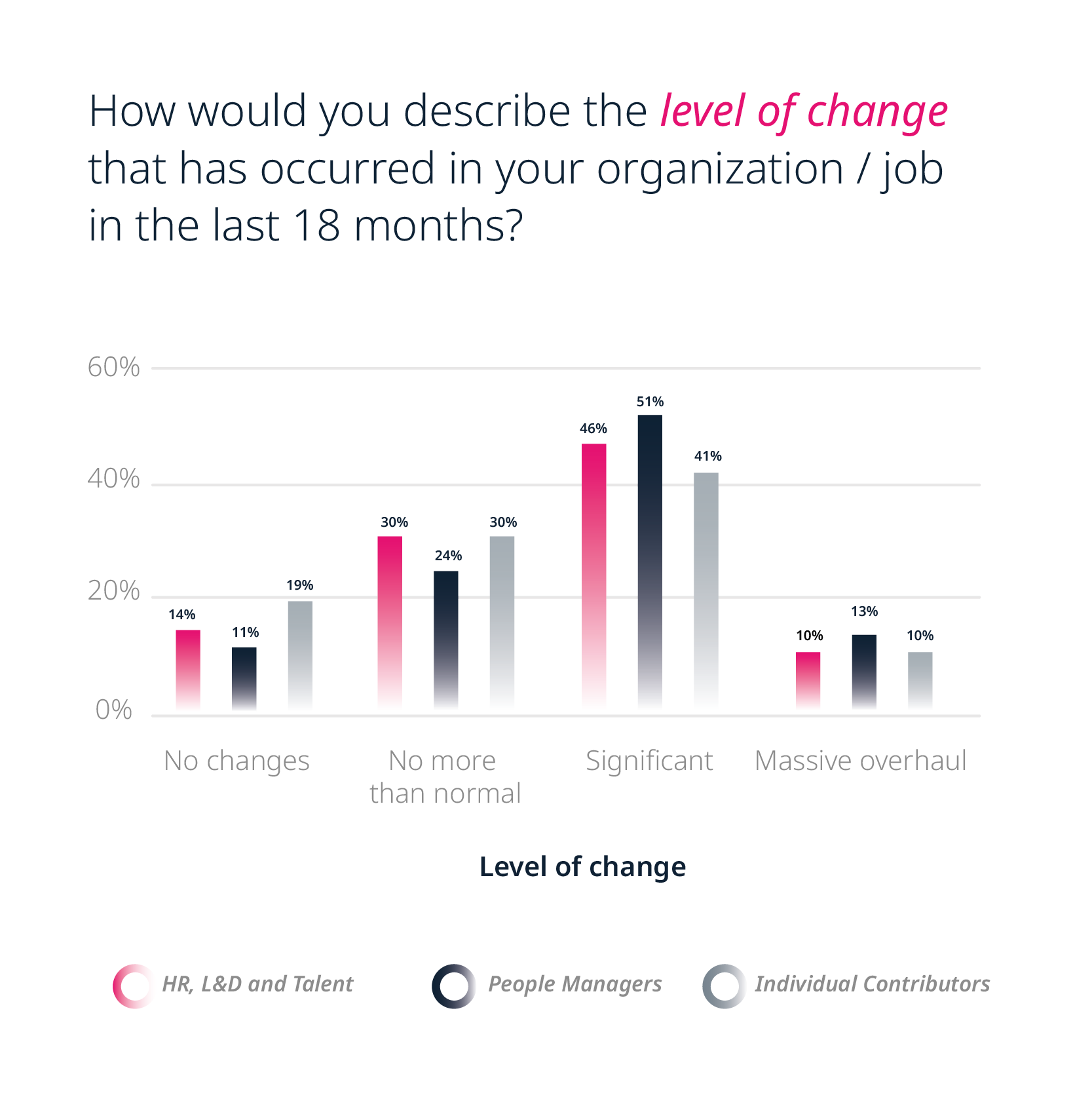
According to Schwab, the 4IR is not simply changing what we do, but “changing us”, with startling ramifications for the future of work as we know it.9
Four main themes of the 4IR:
- Mobility and connectedness
- Globalization
- Makeup of the human population
- Resource scarcity
The eight megatrends of change
There are a number of megatrends in the 4IR that have the power to fundamentally influence the future of employment and skills.10 Understanding how these megatrends might impact work and society is crucial in helping us prepare for the changes that may lie ahead over the next decade and beyond.
Additionally, the shock impact of the COVID-19 pandemic has made a megatrends-based approach to change more relevant than ever, as the rapid adoption of new technologies and other changes brought about by the crisis have suddenly brought broad movements into stark and immediate focus.11 In order to remain competitive and navigate the future of work, business leaders would do well to focus on these megatrends now.
1. The future of urbanization and mobility
Over half the world’s population now lives in cities, with that number likely to increase to over two thirds by 2030.12 This swell in urban dwellers has created an increased demand for new mobility solutions, including e-hailing innovations, autonomous driving, and electrification.13 However, a newfound reluctance for shared commuting as a result of the COVID-19 pandemic may further reconfigure the mobility landscape,14 with telling consequences for the future of work. Management guru Peter Drucker argued in 1993 that commuting to the office would one day become “obsolete”, and it may be the pandemic that ultimately proves him right.15
Enhanced organizational cohesion brought on by technological advances has seen remote working become the name of the game, with nearly half of workers now preferring a model which will let them work from home more often in the future,16 and three in four chief financial officers planning to shift at least five percent of on-site employees to permanently remote positions in the post-COVID-19 world.17 Within a matter of years, the rush-hour commute to the brick-and-mortar office block may be a thing of the past, changing the face of how we work forever.
Explore how disruptive technology is improving the planning, design, and management of contemporary cities for a more resilient future in the Beyond Smart Cities: Emerging Design and Technology online short course from the MIT Media Lab.
2. Globalization
We have just entered into a new phase of globalization – Globalization 4.0 – which will be shaped by a combination of governance and, more overtly, technological developments.18 While there is generally still broad acceptance that globalization is at least somewhat a positive force for good,19 recent years have been notable for increased political polarization,20 and unforeseen resistance to global trade, which has severely impacted those organizations most reliant on international supply chains.21
As we have enhanced our ability to facilitate seamless and real-time cross-border communications, the workplace has become increasingly virtual, connected, and boundaryless.22 This has resulted in an emergence of globally managed workpools,23 where half of global employees are working outside of their main office headquarters for at least half the working week.24 This is likely to increase in a post-COVID-19 world. As the world faces the transformative economic, social, and environmental challenges of Globalization 4.0, it has never been more important to address talent needs from a global perspective.25
Gain an ability to critically analyze global events from multiple perspectives with the Business, International Relations and the Political Economy online certificate course from the London School of Economics and Political Science (LSE).
3. Demographic change and the multigenerational workforce
With people generally living and working longer, there are now as many as five generations active in today’s workplace – from the Silent Generation to Generation Z, with Baby Boomers representing the fastest-growing segment.26
This presents new and unique challenges for any business. Different generations not only have differing ideas of what fulfilling work entails (for instance, Generation Z values training while Baby Boomers crave a sense of purpose),27 but the external expectations placed on workers based on their perceived age and experience – or a lack thereof – may directly interfere with their performance.28 Deft and skillful adaptation is required to align varying goals and perspectives, and get everyone pulling in the same direction.
At the same time, however, a multigenerational workforce can bring significant value and opportunities to the boardroom table. An impressive 89 percent of talent professionals agree that a multigenerational workforce makes their company more successful.29 There are various reasons as to why this may be the case: a multigenerational workforce has been shown to improve continuity, stability, and retention of intellectual capital,30 younger workers tend to enjoy the wisdom, professionalism, and engaged work ethic that their older colleagues provide,31 and mature workers often display stronger relationship skills to an organization’s benefit.32 Longer lifespans also allow for more opportunities to pivot and reinvent yourself, as demonstrated in the illustration below.
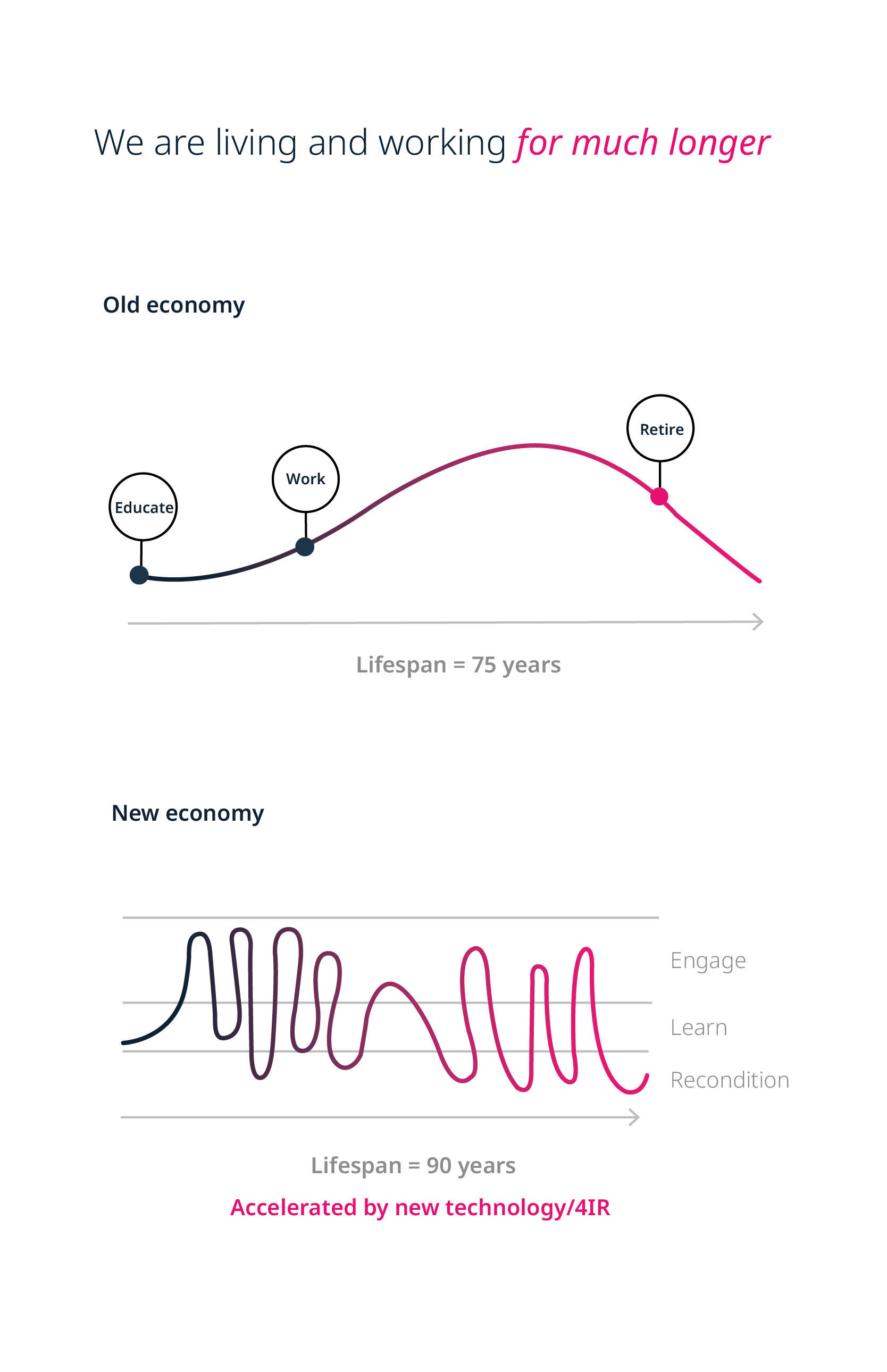
Thus, in the future of work, business leaders must be cognizant of what it takes to inspire and upskill a multigenerational workforce, and to harness diverse levels of talent and experience. Explore GetSmarter’s range of online short courses examining topics like digital operations management and organizational design.
Make digital transformation a strategic priority and optimize your digital business models with the Organizational Design for Digital Transformation online short course from MIT Sloan Executive Education.
4. The changing nature of careers
It’s not just the ‘what’ and ‘where’ of work that’s changing, but also the ‘how’. Work is increasingly becoming about the collective, with almost a third of today’s CEOs agreeing that “most” or “almost all” of their work is now done in teams, and 74 percent seeing a team-based model meaningfully improve their organizational performance.33
Technology is increasing the potential for cooperation and collaboration across multiple platforms, with messaging platforms, video calls, and video conferencing forming the new foundation of the distributed workforce.34 In a recent work survey, three quarters of respondents specifically cited video meeting capabilities and real-time collaboration tools as the key technologies to improve job performance and success at work.35
The nature of the workday and week is already starting to shift, with companies experimenting with remote options over particular days, or with shorter workweeks entirely.36 In broader terms, the way we view the ‘career’ as a concept is under severe scrutiny, as corporate ladder aspirations are reevaluated or go out of the window entirely. Finally, and perhaps most dramatically, a shift in the division of labor between human, robot, and co-bot is changing our conception of what is required of individuals in the labor force and what it means to bridge the gap between jobs and skills.37
Gain the skills to navigate the changing nature of careers in the six-week Corporate Innovation: Strategies for Leveraging Ecosystems online short course from the MIT Sloan School of Management.
5. A nonlinear career continuum
The days of plotting a dream career, and winding up exactly where you anticipated (presumably with a congratulatory fruit bowl or fountain pen as recognition) are long gone. Nearly half of all workers across industries in the U.S. have recently made a dramatic or total career change,38 and research suggests that the next generation is even more likely to switch jobs in a matter of a few years.39 The compressed nature of change, coupled with shorter tenures in both roles and organizations, makes for different career paths to what was the norm 20, or even 10, years ago. Respondents in GetSmarter’s ‘The Future of Work Is Here’ survey confirm that the traditional career path is likely retiring with older generations. Younger generations indicated that they have already filled more positions in their short career spans, and although the percentages are still small, a side gig is becoming an attractive second income generator and skills builder in some industries and job functions.
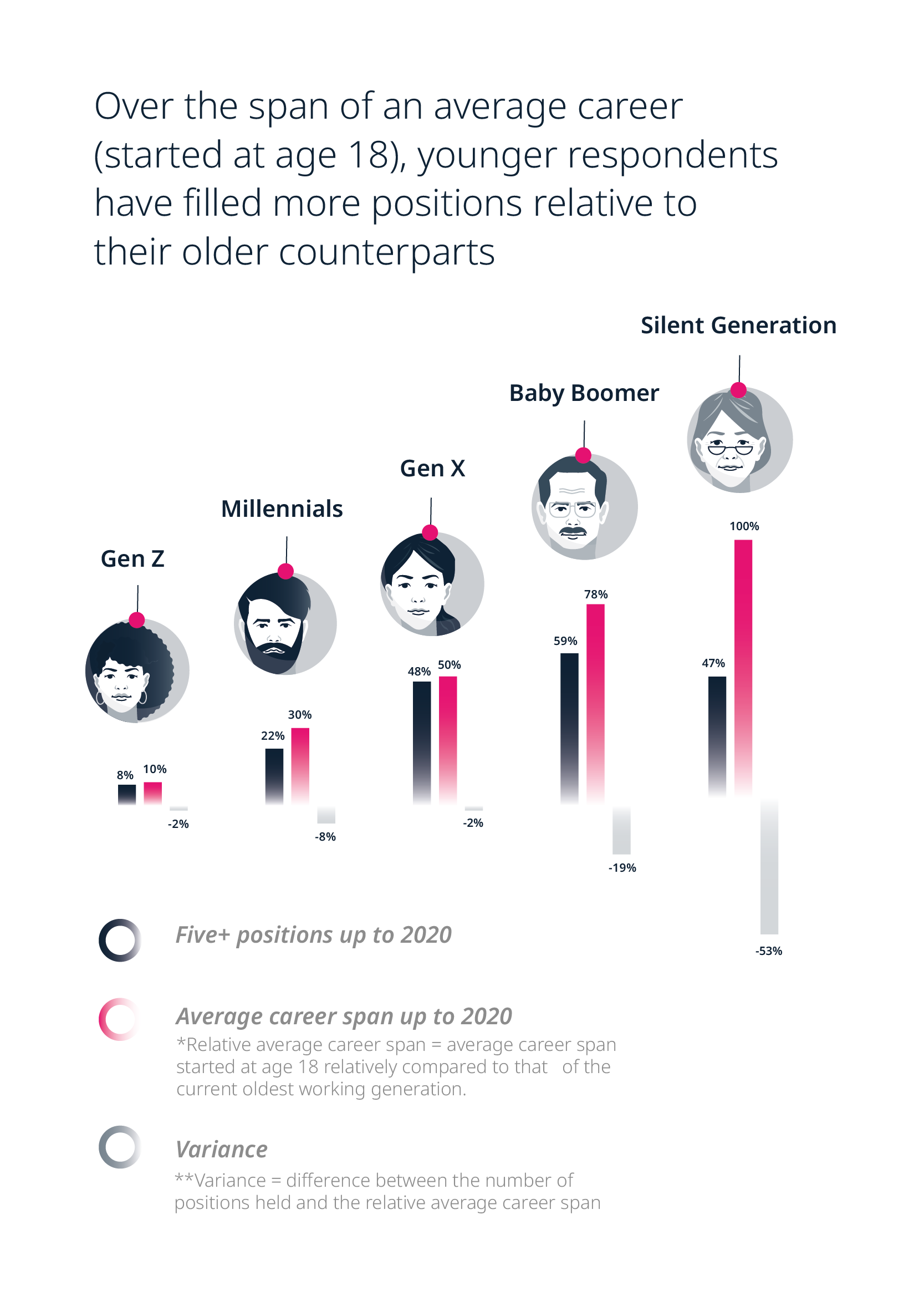
Enhanced connectivity and collaborative technologies have seen self-employment rise to new levels, with approximately 20 to 30 percent of the working population in the U.S. and EU choosing to engage in more independent, on-demand work.40 Further, almost a quarter of these individuals are electing to diversify their income, thanks to a portfolio of jobs and multiple revenue streams.41 With an increasing number of people starting to understand that they don’t necessarily need a workplace to work, it’s predicted that many may give up on the concept of fixed employers and employment altogether.42 These dramatic changes in the way we work will undoubtedly drive many new opportunities for job creation and more flexible modes of work.
Take control of your career trajectory with one of GetSmarter’s online short courses specifically designed to enhance effective leadership.
6. The widening skills gap and skills mismatch
With the rapid advancement and adoption of new technologies comes a clear and significant demand for upskilling.
However, proficiency in new technologies is only one part of the skills equation, as disruptions like automation, machine learning, and artificial intelligence (AI) have placed a new premium on the ‘enterprise’, ‘human’, and ‘soft’ skills that machines cannot master.43 Skills such as creativity, originality and initiative, critical thinking, persuasion, and negotiation are only likely to rise in value, as well as capabilities like an attention to detail, resilience, flexibility, and complex problem-solving.44
This is reflected in our research. Recruiters believe that the biggest skills gap in their organization lies in leadership. We can also see a growing demand for analytical and interpersonal skills from the respondents.
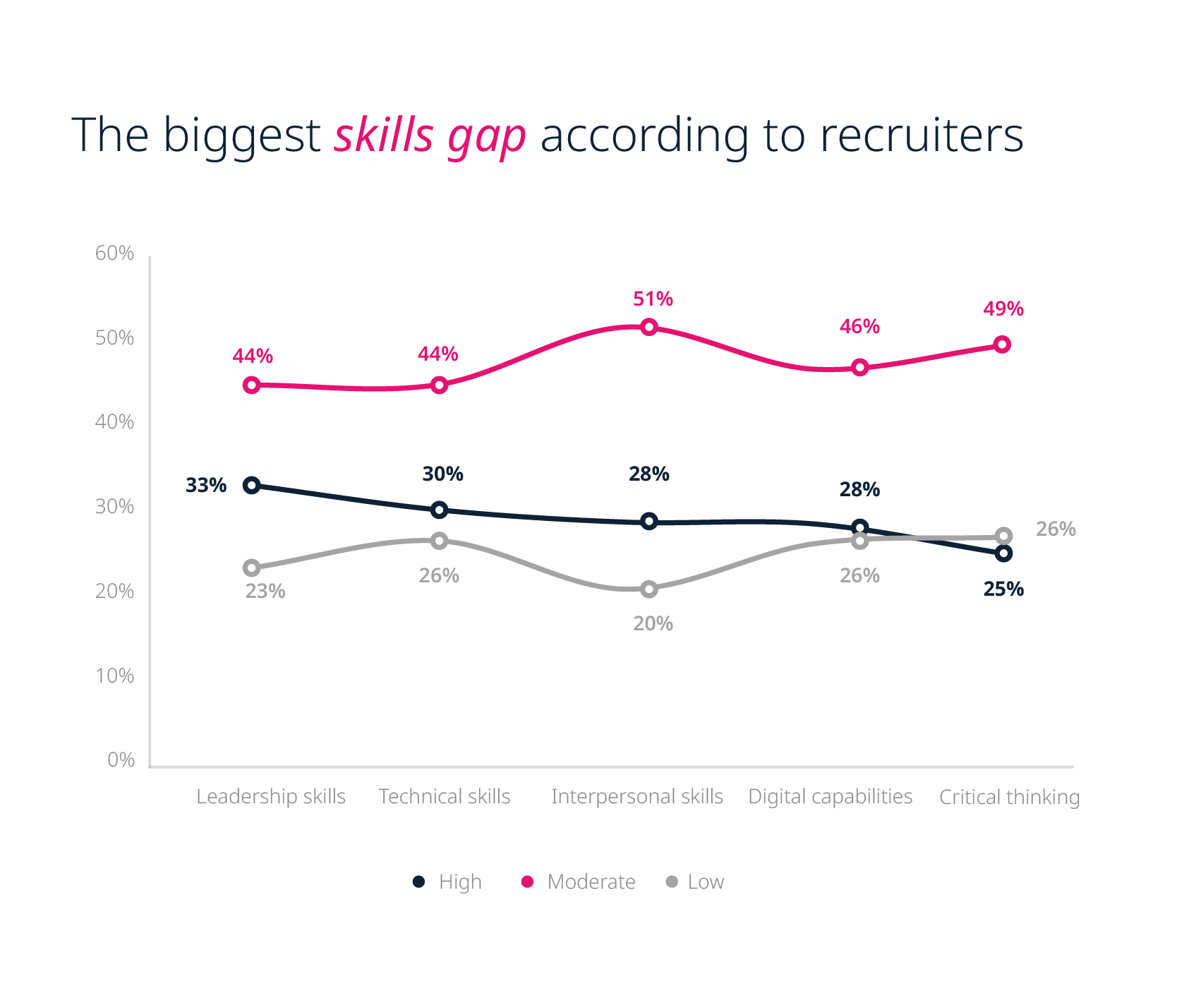
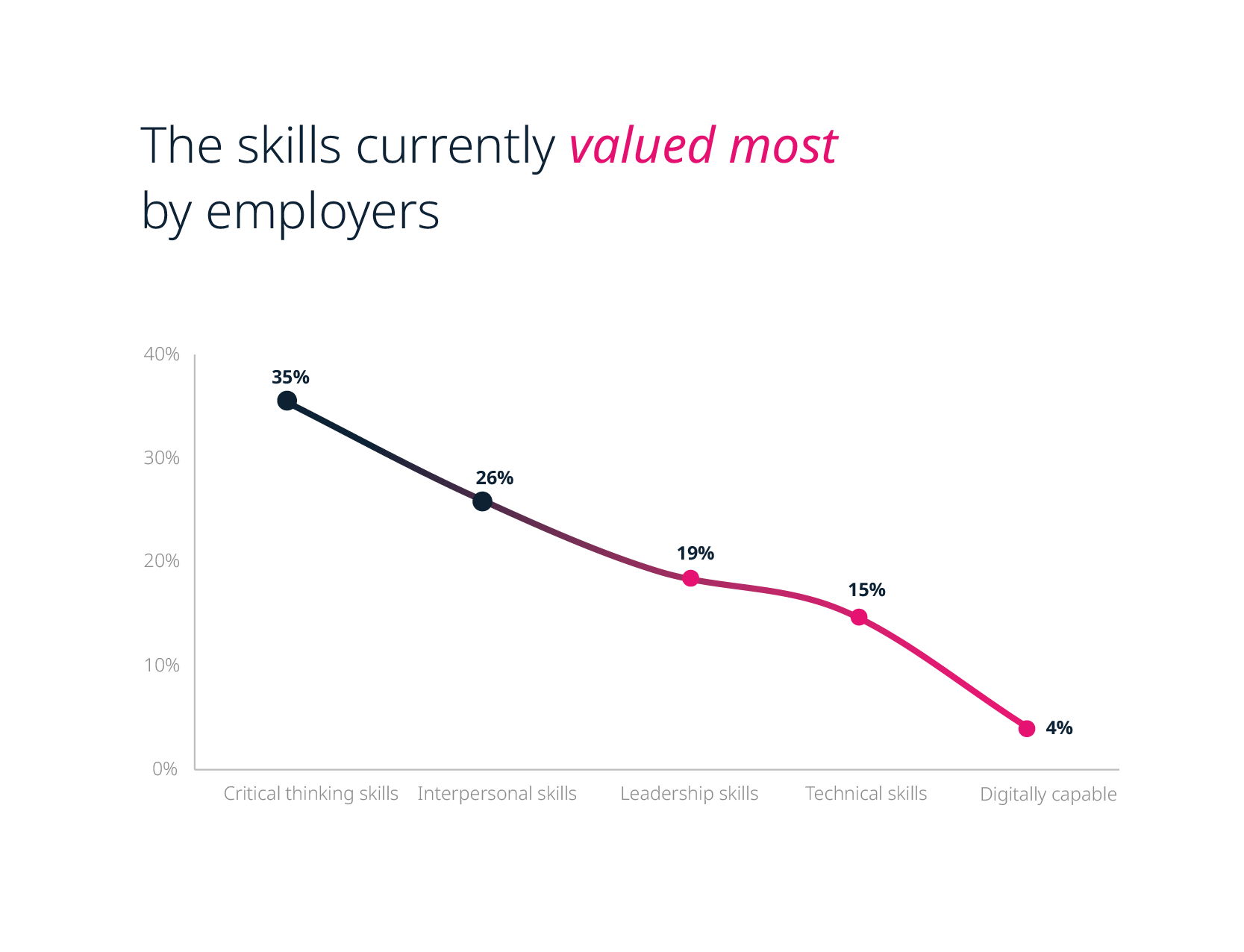
While technical skills like accounting, engineering, or architecture may not necessarily diminish in importance, they will no longer be sufficient to get a job or improve pay without the support of a broader tool kit of these more human skills.45
As a result of this change, reskilling has become a major concern and priority for as much as 80 percent of business executives, with that number likely to rise.46
To support this knowledge, online short courses in fintech, blockchain, and data science and analysis are available, helping you lead technical implementation with an understanding of the human element.
7. Resource scarcity and climate change
While many may erroneously still consider it to be a ‘future dated’ threat, climate change and resource scarcity is already affecting many facets of everyday life. The business impact is certain to be drastic, with risks related to climate change likely to cost 215 of the world’s biggest corporations as much as $1 trillion in the decades ahead.47
As regulations around carbon and energy standards and efficiencies are implemented, organizations must make greater preparation for a potential rise in operational and investment costs.48 It should come as little surprise then that climate change concerns have soared up many a CEO’s agenda.49
However, where there’s risk, there’s also opportunity, as it’s also estimated that companies worldwide have as much as $2.1 trillion to gain from facilitating a low-carbon transition in the coming years.50 The majority of jobs will be transformed or redefined in terms of their profile requirements and working methods, and ‘green’ initiatives are likely to result in the creation of multiple new professions.51 Those organizations that innovate by putting climate change at the center of their strategic planning and successfully build a low-carbon, high-resilience supply chain can look forward to reduced costs and increased efficiencies.52
Discover GetSmarter’s full range of business sustainability online short courses.
8. Advancing technologies and automation
It’s estimated that three-quarters of global companies have already started to automate their business processes or plan to do so soon.53 Automation, robotics, machine learning, AI, and digitization are changing the way business is done, and organizations must adapt to stay relevant or risk falling behind.
Understandably, there is significant fear of job loss as tasks once carried out by humans are handed over to machines. A majority of workers worry that automation will significantly change or make their job obsolete within the next decade,54 and as many as 120 million workers in the world’s 12 largest economies may need to be retrained in the next three years as a result.55
However, while there is no doubt that technology will continue to replace tasks across industries and functions, this digital transformation will also bring with it new opportunities. The World Economic Forum predicts innovative technology will create 58 million more jobs than it removes from the economy in the next few years,56 and opportunity knocks for those who are willing and able to diversify their skill sets.
Whether you’re an automation optimist or pessimist, it’s undeniable that these technologies will significantly impact the job picture, with the development of wholly new tasks and jobs to keep up with the change.57
GetSmarter offers a range of online short courses that can better prepare you to navigate a technological future, covering subjects including information technology and cybersecurity and artificial intelligence.
The future of work
GetSmarter’s ‘The Future of Work Is Here’ report revealed that a majority of respondents point to technology as one of the main drivers of change within their organizations over the past 18 months. Perhaps more importantly, they also expect tech to be the number one driver of change in the next 18 months.
While this inevitability has given rise to some commentators predicting a gloomy outlook for the global workforce,58 closer inspection of this research paints a somewhat different picture. It’s clear that respondents don’t view technology and automation as interchangeable entities. In fact, the latter is scored relatively low in terms of future impact. So how exactly do tech and automation differ, and what are we to make of this discrepancy in weighting?
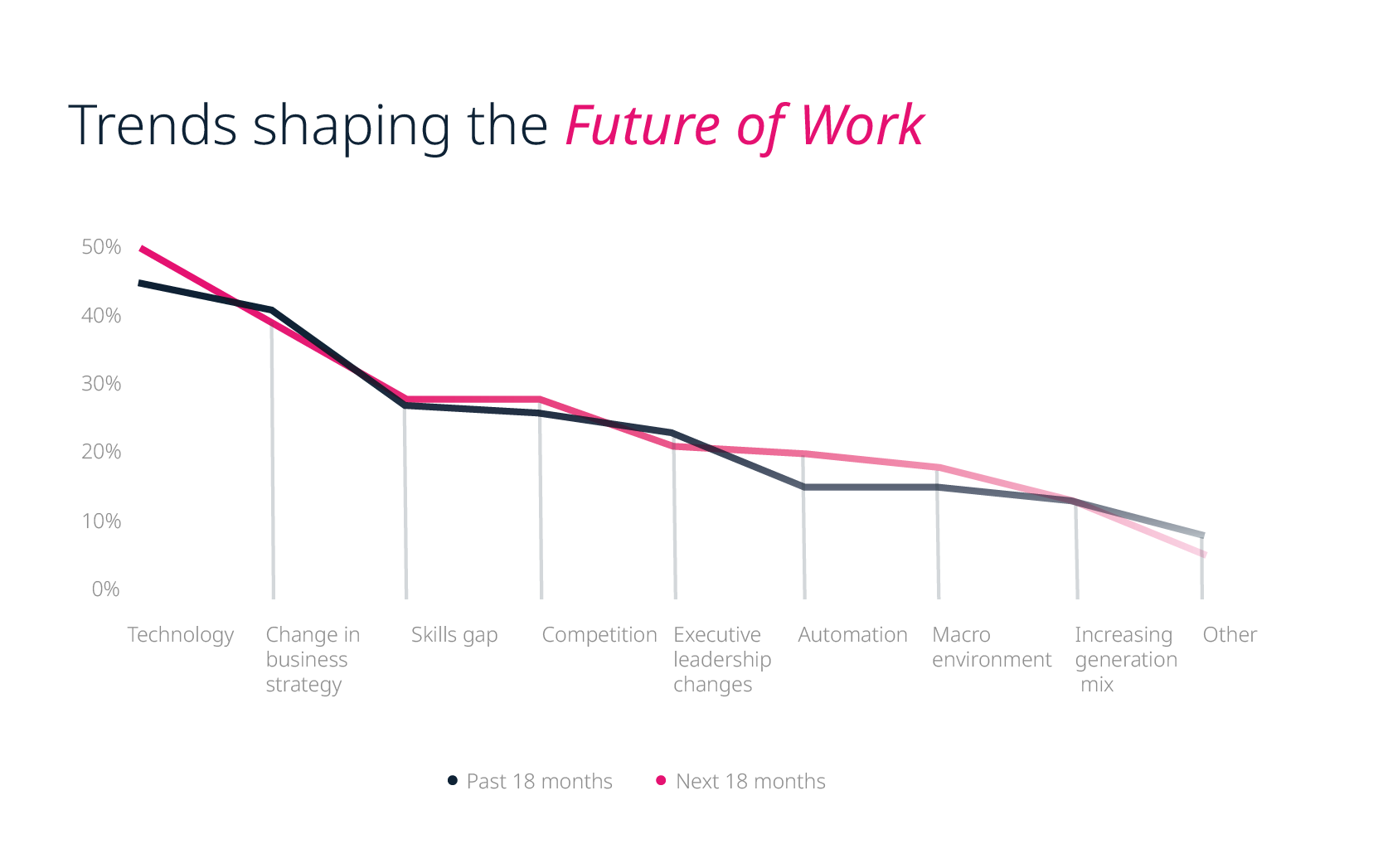
Automation versus tech-driven changes
Automation quite simply refers to the process by which certain tasks that were once completed by a human are now completed by a machine. It’s the application of technology, programs, robotics, and processes to achieve outcomes with minimal human input.59
Technology (or technology-driven changes), on the other hand, more broadly refers to the process of digital transformation and the creation of value-add activities through a complex intersection of human intelligence and catalytic innovation.
Thus, while automation may indeed cause significant disruption to the human role in sectors such as manufacturing,60 tech-driven changes can create (rather than replace) value across a range of industries, including health care, education, science, and business. When the technology as the number one trigger of change works in tandem with the most required human skills, high-quality, premium-value activities and progress can be unlocked.
A bright future?
It’s clear from GetSmarter’s future of work research that respondents expect basic automation to be less disruptive than tech-driven changes with a potentially more universally positive impact. Not only has the rate of automation tended to be slower than the rate of expected change, but widespread automation adoption requires financial, social, and cultural acceptance, which may well result in the brakes being applied for a few years to come. Ultimately, the research suggests that cautious optimism may well be in order, provided humans remember their position as the ongoing source of influence in creating and capturing this additional value.
In conclusion
Ours is an ever-changing world that shows no signs of slowing in the Fourth Industrial Revolution. The skills and knowledge that mattered today might not matter tomorrow,61 and there is little doubt that technology will be one of the biggest catalysts for organizational change in the years and decades that lie ahead.
However, as we have seen, the future of work remains distinctly human, and technology must be matched with those most human of interpersonal, analytical, and leadership skills in order to direct it and bring about full-scale transformation. Technology may provide the spark, but the next challenge any business faces is the human problem, as it’s only people who have the skills to drive and deal with the effects of this change.
Learn how to leverage a human-centered approach to effectively navigate digital change in your business on the Managing the Human Side of Digital Disruption online program from MIT Sloan Executive Education.
How prepared are you for the future of work?
Explore the rest of this series of blog articles here
Stay Competent, Confident, and Informed
Sign up to our monthly newsletter to receive the latest course information, expertise from renowned thought leaders, and a summary of our most recent blog articles.
- 1 (2020). ‘Modified Enterprise Risk Management: Building resilience in a changing operating environment’. Retrieved from Deloitte.
- 2 Lepsinger, R. (Sep, 2019). ‘5 Ways Agile Leaders Navigate a VUCA World’. Retrieved from Business 2 Community.
- 3 Bruce, J. (Jan, 2020). ‘The future of work is now: Embrace the uncertainty’. Retrieved from Forbes.
- 4 Bughin, J. et al. (Oct, 2019). ‘Digital transformation: Improving the odds of success’. Retrieved from McKinsey.
- 5 (Jan, 2019). ‘Leading through the Fourth Industrial Revolution: Putting People at the Centre’. Retrieved from the World Economic Forum.
- 6 Schulze, E. (Jan, 2019). ‘Everything you need to know about the Fourth Industrial Revolution’. Retrieved from CNBC.
- 7 Hinton, S. (Oct, 2018). ‘How The Fourth Industrial Revolution Is Impacting The Future of Work’. Retrieved from Forbes.
- 8 Yun Kim, S. (Jul, 2019). ‘The Fourth Industrial Revolution: Trends and Impacts on the World of Work’. Retrieved from Springer.
- 9 Valkova, T. (Oct, 2018). ‘Trends shaping the future of jobs until 2022’. Retrieved from EFMD Global.
- 10 (Nd). ‘The Future of Skills’. Retrieved from Pearson. Accessed 09 July 2020.
- 11 (2020). ‘Are you reframing your future or is the future reframing you?’. Retrieved from EY.
- 12 (Sep, 2019). ‘Cities: a ’cause of and solution to’ climate change’. Retrieved from UN News.
- 13 Möller, T. et al. (Dec, 2019). ‘The future of mobility is at our doorstep’. Retrieved from McKinsey.
- 14 Bert, J. et al. (Jun, 2019). ‘How COVID-19 Will Shape Urban Mobility’. Retrieved from BCG.
- 15 Grant, A. (Jun, 2020). ‘Adam Grant on how jobs, bosses and firms may improve after the crisis’. Retrieved from The Economist.
- 16 (2020). ‘National survey: A majority of US employees want remote work arrangement to stay’. Retrieved from getAbstract.
- 17 (Apr, 2020). ‘Gartner CFO survey reveals 74% intend to shift some employees to remote work permanently’. Retrieved from Gartner.
- 18 (Apr, 2019). ‘Globalization 4.0: Shaping a New Global Architecture in the Age of the Fourth Industrial Revolution’. Retrieved from the World Economic Forum.
- 19 Radu, S. (Jun, 2019). ‘The World Still Believes in Globalization’. Retrieved from U.S. News & World Report.
- 20 (Jan, 2020). ‘Economic, political polarisation to rise in 2020; Threats to climate among biggest risks: WEF survey’. Retrieved from Financial Express.
- 21 Barghini, T. (Jan, 2020). ‘Globalization 4.0’. Retrieved from Global Finance.
- 22 (2020). ‘DHL Global Connectedness Index’. Retrieved from DHL.
- 23 (2020). ‘2020 Global Talent Trends Study’. Retrieved from Mercer.
- 24 (Mar, 2019). ‘The IWG Global Workspace Survey’. Retrieved from International Workplace Group.
- 25 (Feb, 2020). ‘Beyond hiring: How companies are reskilling to address talent gaps’. Retrieved from McKinsey.
- 26 Taylor, C. (Nov, 2019). ‘Baby boomers will be the fastest-growing generation in the workforce next year, Glassdoor claims’. Retrieved from CNBC.
- 27 (2020). ‘Global Talent Trends’. Retrieved from LinkedIn.
- 28 King, E. et al. (Aug, 2019). ‘Generational Differences At Work Are Small. Thinking They’re Big Affects Our Behavior’. Retrieved from Harvard Business Review.
- 29 (2020). ‘Global Talent Trends’. Retrieved from LinkedIn.
- 30 Whitman, D. (Nov, 2019). ‘Here’s what you need to know about the future of multi-generational working’. Retrieved from the World Economic Forum.
- 31 (2020). ‘Global Talent Trends’. Retrieved from LinkedIn.
- 32 Schwartz, J. et al. (Dec, 2018). ‘No time to retire: Redesigning work for our aging workforce’. Retrieved from Deloitte.
- 33 (2019). ‘Leading the social enterprise: Reinvent with a human focus’. Retrieved from Deloitte.
- 34 (Jan, 2020). ‘Collaborating on the future of work’. Retrieved from VentureBeat.
- 35 (Oct, 2019). ‘Collaborative Tech: Must-Haves For Workplace Flexibility’. Retrieved from Inc.
- 36 Grant, A. (Jun, 2020). ‘Adam Grant on how jobs, bosses and firms may improve after the crisis’. Retrieved from The Economist.
- 37 O’Donnellan, R. (May, 2019). ‘Trends 2019: The Future of Work and the Shape of Future Skills’. Retrieved from Intuition.
- 38 Liu, J. (Oct, 2019). ‘Nearly half of workers have made a dramatic career switch, and this is the average age they do it’. Retrieved from CNBC.
- 39 (Nov, 2019). ‘Young adults switch jobs after less than four years, study reveals’. Retrieved from Express.
- 40 (Apr, 2020). ‘Globalization 4.0: Shaping a New Global Architecture in the Age of the Fourth Industrial Revolution’. Retrieved from the World Economic Forum.
- 41 Pofeldt, E. (May, 2020). ‘Survey: Nearly 30% Of Americans Are Self-Employed’. Retrieved from Forbes.
- 42 Grant, A. (Jun, 2020). ‘Adam Grant on how jobs, bosses and firms may improve after the crisis’. Retrieved from The Economist.
- 43 (2018). ‘The Future of Jobs Report’. Retrieved from the World Economic Forum.
- 44 (May, 2018). ‘Skill Shift: Automation and the Future of the Workforce’. Retrieved from McKinsey.
- 45 Anderson, B. (Jan, 2020). ‘The Most In-Demand Hard and Soft Skills of 2020’. Retrieved from LinkedIn.
- 46 Avrane-Chopard, J. et al. (Nov, 2019). ‘How to develop soft skills’. Retrieved from McKinsey.
- 47 Plumer, B. (Jun, 2019). ‘Companies See Climate Change Hitting Their Bottom Lines in the Next 5 Years’. Retrieved from New York Times.
- 48 Gambarelli, G. (Jun, 2020). ‘Climate change, new risks and opportunities for businesses’. Retrieved from Lifegate.
- 49 (Jan, 2020). ‘Climate change soars up CEO agenda’. Retrieved from PwC.
- 50 (Jun, 2019). ‘World’s biggest companies face $1 trillion in climate change risks’. Retrieved from CDP.
- 51 (Nd). ‘Frequently Asked Questions on Climate Change and Jobs’. Retrieved from International Labour Organization. Accessed 09 July 2020.
- 52 Sijbesma, F. and Verkooijen, P. (Jul, 2019). ‘Climate Change Is Making It Harder for Us to Feed Ourselves’. Retrieved from Fortune.
- 53 (Sep, 2018). ‘The automation imperative’. Retrieved from McKinsey.
- 54 (Sep, 2019). ‘PwC publishes results of global survey on technology, jobs and skills’. Retrieved from PwC.
- 55 (Sep, 2019). ‘The enterprise guide to closing the skills gap’. Retrieved from IBM.
- 56 (Jan, 2020). ‘Jobs of tomorrow: mapping opportunity in the new economy’. Retrieved from the World Economic Forum.
- 57 Le Clair, C. (Apr, 2019). ‘How Automation Is Impacting Enterprises In 2019’. Retrieved from Forrester.
- 58 (2018). ‘The Future of Jobs Report’. Retrieved from the World Economic Forum.
- 59 (Nd). ‘What is automation?’. Retrieved from IBM. Accessed 10 July 2020.
- 60 (Sep, 2018). ‘The automation imperative’. Retrieved from McKinsey.
- 61 Brandon, J. (Feb, 2020). ‘This is what the future of work will look like (and how you can prepare for it)’. Retrieved from The Ladders.